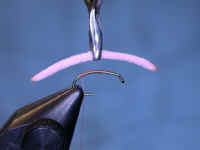|
Fly of the Month Bob Ireton brings together his experience in fly fishing, aquatic entomology, and knowledge of fly tying techniques and materials, to design and tie durable and effective flies. |

|
![]()
Volume 4, Issue 8 August
2003
![]()
AQUATIC EARTHWORM
Fly, Text, and Photography by Bob Ireton
Most folks don't realize that there are maybe 200 species or more of aquatic earthworms in North America. I am not talking about the earthworms you dig for in your garden to fish for sunfish. Although not much is known about the aquatic variety, they are well represented in freshwater environments. They are generally elongate, cylindrical worms that are usually 1-30 mm, but sometimes well over 100 mm in length. The body is segmented, and typically bears a few short bristles or hairs. Color is variable, but the ones I have collected in Southwestern Ohio are a very pale pinkish color. Most aquatic earthworms may be found in silty substrates and among the debris and detritus of ponds, lakes, streams, and rivers.
We all know that earthworms catch fish. The 'San
Juan Worm' is an example of a fly that represents a worm. I suspect it was
tied to represent a generic earthworm. This fly is tied in a variety of
colors. If you know what color the aquatic worms are in the area you fish,
tie using this color. I suspect that one tied with a pale pink chenille
will work in most areas. If the fly is tied too long, you will get a lot
of short strikes, so with this in mind, I will tie this fly approximately
25 mm in length.
MATERIALS
Hook - TMC 2487 or equivalent.
Size - 14
Thread - 8/0 pink.
Body - Pink ultra chenille.
TYING STEPS - click on pictures for larger view
![]()
Copyright © 1998 - thisyear The Buckeye United Fly Fishers, Inc. Cincinnati, OH 45242
The Buckeye United Fly Fishers, Inc is a non-profit corporation organized under section 501(c)(3) of the Internal Revenue Code, incorporated in the State of Ohio for the preservation, conservation and wise use of our fishing waters and game fish; and to assist in the protection and improvement of our natural resources






